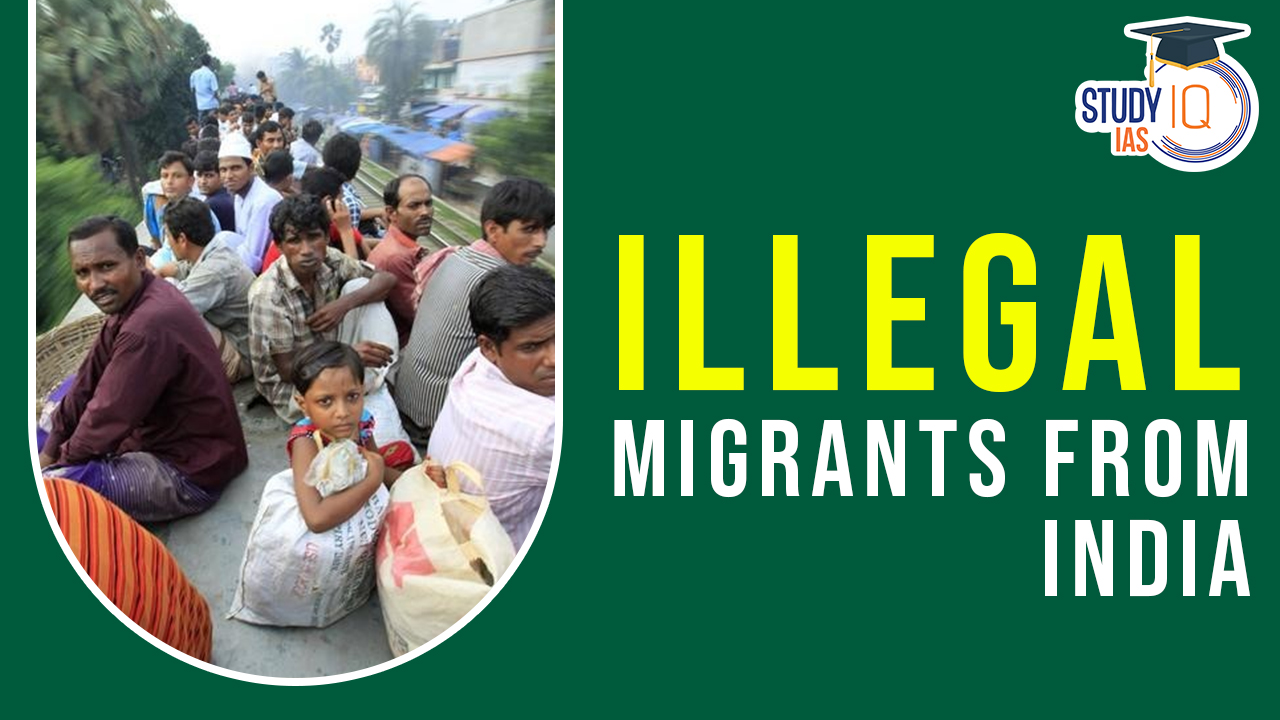Table of Contents
Context: The recent incident, involving the forced return of 303 Indians detained at a French airport, highlights the crisis of forcing youths to take to illegal migration.
Illegal Migration: An Overview
- Illegal migration from India to the United States has seen a significant increase in recent years, as indicated by data from the U.S. Customs and Border Protection.
- The period from November 2022 to September 2023 marked a notable surge, with as many as 96,917 Indians being apprehended for illegal entry into the U.S.
- This figure demonstrates a stark rise compared to previous years: 19,883 Indians were detained in 2019-20, 30,662 in 2020-21, and 63,927 in 2021-22.
- This escalating trend highlights the growing challenge of illegal migration, reflecting a range of socio-economic factors that compel individuals to undertake such risky journeys.
We’re now on WhatsApp. Click to Join
Factors for Illegal Migration From India
Push Factors in India
- Lack of Job Opportunities and Economic Prospects: Many individuals in India face insufficient job opportunities and economic prospects, prompting them to seek better employment abroad.
- Agricultural Crisis: Low agricultural productivity, debt burdens, and unpredictable weather patterns have contributed to agrarian distress, particularly in rural areas like Punjab, leading to a drop in incomes and increased vulnerability.
- Unemployment: High youth unemployment, especially in rural regions, is a significant driver of illegal migration.
- Poverty and Economic Hardship: These factors are major motivators for individuals seeking better livelihoods abroad.
- Lack of Educational Opportunities: Limited access to quality education restricts skill development, pushing youths towards unskilled jobs overseas.
- Social Pressures: Family and societal expectations for financial stability contribute to the migration decision.
- Ineffective Governance Policies: Paralysis in the implementation of government policies related to agriculture and employment exacerbates the situation.
- Trafficking and Exploitation: Widespread trafficking rackets, especially in regions like Punjab and Haryana, mislead individuals with promises of a better future abroad.
Pull Factors in the Destination Countries (e.g., the USA)
- Better Employment and Higher Wages: The reputation of countries like the U.S. for offering lucrative job opportunities acts as a significant draw.
- Quality Education: The allure of prestigious academic institutions in the U.S. attracts students and families.
- Family Reunification: The desire to be closer to family members already settled in countries like the U.S. is a strong motivator.
- Fear of Religious and Political Persecution: This has been identified as one of the reasons for the rise in illegal migration from India, particularly among minority communities.
Global Trends and Visa Backlogs
- The rise in global migration trends following the pandemic has contributed to the surge.
- Visa backlogs have forced individuals to explore alternative, albeit illegal, pathways to enter countries like the U.S.
Way Forward
- Revamping Agricultural Policies: Implementing improvements in schemes like PM-KISAN to incorporate technological advancements and enhance market accessibility. This approach aims to bolster agricultural incomes and alleviate distress in this sector.
- Enhancing Employment Opportunities: Broadening the scope of the MGNREGA program and launching initiatives tailored to specific sectors to stimulate job growth, particularly in rural regions.
- Fostering Education and Skill Enhancement: Investing in educational infrastructure and encouraging vocational training via initiatives like the Skill India Mission to build a skilled workforce.
- Strengthening Social Welfare Schemes: Expanding the effectiveness of existing social welfare programs to better meet the needs of vulnerable groups within the population.
- Global Partnerships and Cooperation: Establishing collaborative efforts with countries like the United States and European nations to exchange best practices and develop equitable and legal migration channels.


 GPS Spoofing and Its Impact in India: A ...
GPS Spoofing and Its Impact in India: A ...
 Amrit Gyaan Kosh Portal: A Comprehensive...
Amrit Gyaan Kosh Portal: A Comprehensive...
 UpLink Initiative: Launched by World Eco...
UpLink Initiative: Launched by World Eco...





















